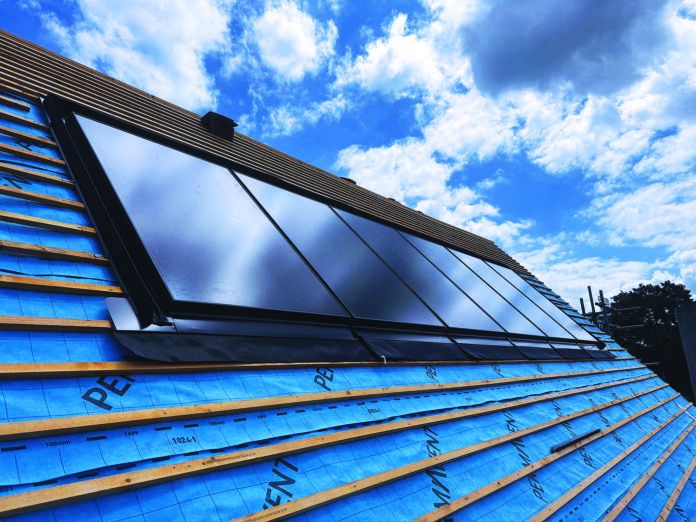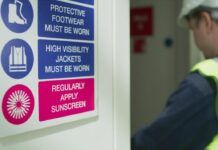Pitched roofs are now are becoming more complex in design on most new build house types. The days of the simple up and over roof are lesser with the complexity of the roof paramount to the overall design of the finished house. Hipped, cross hipped, cross gable designs are commonplace removing the mundane new build house look and providing variety in the way we plan and build modern housing.
As with everything, the more complex the detail, the greater the requirement for good workmanship and changes to more dry fixed products have been of significant benefit to the roofing industry in the last decade. However, one area that is constantly overlooked is roof space ventilation below and above the roofing underlay. Traditional cross flow eaves ventilation was always considered to provide significant airflow into the attic space to eliminate any potential condensation risk working on the principle of air in and air out, in a cross flow movement. The idea in principle works, however, the intricacy of modern roof design coupled with increased insulation at eaves has the potential to render any cross flow ventilation at low level ineffective.
The increase in solar panel installations in both new build and refurbishment housing markets has the potential to cause problems with condensation in the roofspace. A problem that a number of years ago, the introduction of vapour permeable underlays and air and vapour permeable underlays has in most cases eradicated. Modern day living, 2 to 3 bathrooms per property and a reluctance to ventilate the habitable living spaces, means that condensation in most housing is inevitable.
As we adopt increased levels of airtight and energy efficient homes condensation is increasing and we must effectively remove warm heavy air from the cold attic space. Sadly, the regulations regarding ventilation (background) have remained the same despite houses becoming more hermetically sealed. The general movement of warm air has further increased into the attic space with traditional eaves ventilation not able to provide a consistent movement of fresh air.
An air and vapour open membrane for example, provides air flow across the whole of the roof as well as diffusion of warm air through the underlay 24 hours a day 7, days a week, 365 days a year and is not dependent on other factors for example, such as wind movement, to provide cross flow ventilation particularly in complex roof designs.
>>Come visit Permavent’s on stand 11B at the RCI Show.
The guidance of NHBC Technical standards – follows the guidance of BS 5250;2021 Management of Moisture in buildings and suggests the roof covering should be treated as impermeable due to the introduction of solar panels. Some manufacturers have not helped the situation by marketing type HR impermeable as “solar” membranes if used in conjunction with ventilation, when NHBC guidance clearly state that a type LR vapour permeable or air and vapour permeable underlay can also be used below solar panels.
The significant benefit in using an air and vapour permeable roofing underlay allows air movement into the attic space (cross flow) allowing pocketed stagnant warm air removal from the attic space meaningfully and reliably better than eaves ventilation where the air path can be blocked.
One easy option as a roofing underlay manufacturer might have been to take one of our existing impermeable membranes and rebrand the product as solar membrane, a solution we believe to be a backward step in terms of condensation control in the attic space. Work undertaken by Permavent in condensation risk analysis confirms that when installing solar panels on one elevation with the roof covering to the remainder of the roof being air permeable (natural slates concrete tiles) in conjunction with the industry leading Permavent Apex air and vapour open underlay, condensation in the roofspace across was not evident. The same evidence was demonstrated during the Partners in innovation research that an air and vapour permeable roofing underlay provided the best solution to roofspace condensation control.
The importance of the roof covering being natural slates or tiles is also significant given, warm air will find the path of least resistance and be drawn out as expected and in most cases, the m² of the permeable outer roof covering exceeding the m² of the impermeable solar panels.
The guidance is confusing and can be misleading. The Permavent Technical team can provide support and the correct robust solution to ensure the roofspace remains problem free.
We have also seen issues with integrated solar panel installations and fixing screws (60mm) being supplied penetrating the tile batten and breaching the underlay which, is a major cause of water ingress and roof failure. In Europe, solar panels are installed on a counter batten removing the risk of the underlay being breached by an errant fixing. The counter batten also assists with the heat dispersion from the panel.
An extremely costly mistake to remediate
Air open vapour open roofing underlay provides the best solution to complex roof designs where stagnant pockets of warm air can and will develop. Modern housing is more complex with increased bathrooms, higher levels of airtightness, and we run the risk of going backwards in our approach to roofspace condensation control. Having been involved since the inception of vapour permeable (type LR) underlays and the unquestionable difference an air open membrane can provide to the roof space…… why go backwards?




